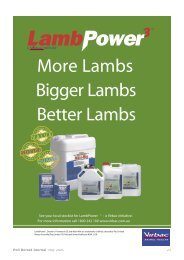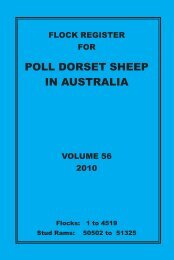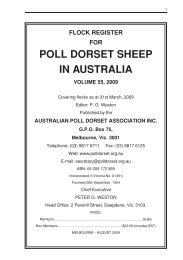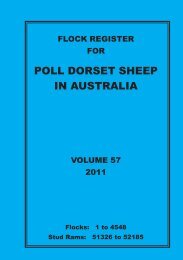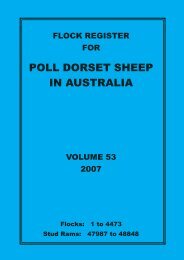2012 flock register vol 58.pdf - Australian Poll Dorset Association Inc
2012 flock register vol 58.pdf - Australian Poll Dorset Association Inc
2012 flock register vol 58.pdf - Australian Poll Dorset Association Inc
You also want an ePaper? Increase the reach of your titles
YUMPU automatically turns print PDFs into web optimized ePapers that Google loves.
46<br />
members on all matters relating to the <strong>Association</strong> and the <strong>Poll</strong> <strong>Dorset</strong> Breed.<br />
To achieve these aims, the Inspector should:-<br />
(a) Make himself thoroughly conversant with the <strong>Association</strong> Statement of<br />
Purposes and Rules and Regulations, paying particular attention to<br />
Regulations 7, 15, 16, 17, 18,19, 21, 22, 23 and 26.<br />
(b) Make himself thoroughly conversant with the “Standard of Excellence of <strong>Poll</strong><br />
<strong>Dorset</strong> Sheep” and the defects listed (a) to (l) above.<br />
(c) Make himself thoroughly conversant with the various abnormalities of the<br />
testes including size. In inspecting for abnormalities, the Inspector should<br />
always give the ram the benefit of any doubt, only rejecting positively<br />
identifiable abnormalities, or upon the opinion of a qualified sheep veterinarian.<br />
A. THE STUD SALE AND SHOW INSPECTOR<br />
The pre-show Inspector is often acting in the dual capacity of representative of<br />
the Show Society, as well as the Breed <strong>Association</strong>. In addition to ensuring that<br />
each exhibit conforms to the standard of type and soundness laid down by the<br />
<strong>Australian</strong> <strong>Poll</strong> <strong>Dorset</strong> <strong>Association</strong> <strong>Inc</strong>., he must also see that each exhibit<br />
conforms to the rules of the Show Society with relation to fairness of preparation,<br />
wool length, correct age for class, etc.<br />
In making rulings, the pre-show inspector must clearly state whether it is a breed<br />
requirement or a show requirement that is in<strong>vol</strong>ved.<br />
The Show Inspector should also have in mind the fact that he is approving for<br />
public inspection a display window of the Breed.<br />
There may be sheep entered of reasonable quality, but in very poor physical<br />
condition, making bad publicity for the Breed. Owners should be asked to<br />
withdraw these animals. The rules of most Show Societies allow for this<br />
eventuality.<br />
INTERPRETATION:<br />
Some Inspectors, Breeders and Judges have been at a variance with regard to the<br />
interpretation of type, colour, mouths, wool, scur growth. This is understandable and<br />
must be expected and even accepted, up to a point. Such differences of opinion<br />
among Breeders exist in all breed societies. However, it is possible to minimise<br />
confusion by agreeing on broad principles in some cases, and by having explicit<br />
regulations in others.<br />
1. Type<br />
The combination of two, three or more minor defects can sometimes make an<br />
animal so “off type” as to reach culling point. For instance an otherwise good ram<br />
could be pigmented around the lips and anus, have paper-thin hairless ears and<br />
perhaps a rather effeminate head - a combination which would give no chance<br />
in stud company. However, any one of these defects in an otherwise good<br />
animal, would be passed.<br />
2. Pigmentation<br />
Guidance to Breeders and Inspectors<br />
Registered <strong>Poll</strong> <strong>Dorset</strong> sheep shall be essentially white hooved, white woolled,<br />
pink skinned and relatively free from all types of pigmentation. Inspectors shall<br />
reject sheep with excessive pigmentation of the hooves or skin or with any wool<br />
pigmentation.



